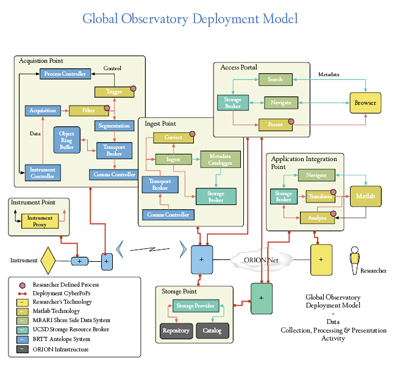UC San Diego Selected to Design, Build Cyberinfrastructure for Ocean Observatories
San Diego, CA, May 16, 2007 -- What we know about the world’s oceans comes largely from ship-based scientists taking samples and making measurements at periodic intervals. Now researchers led by Scripps Institution of Oceanography at the University of California, San Diego will create a blueprint for digital infrastructure that will allow ocean observatories to collect, process and transmit data 24 hours a day, seven days a week.
|
Joint Oceanographic Institutions (JOI), Inc., has selected UC San Diego to design and construct information technology and networking for the Ocean Observatories Initiative (OOI). The initial $29 million Cyberinfrastructure (CI) award is for six years, and total funding may reach more than $42 million over the course of the planned 11-year project. [To read JOI's news release, click here .]
The UCSD division of the California Institute for Telecommunications and Information Technology (Calit2) will manage the project and, together with Scripps and the San Diego Supercomputer Center (SDSC), will design and build the cyberinfrastructure.
“Routine, long-term measurement of episodic oceanic processes is crucial to continued growth in our understanding and predictive modeling of complex natural phenomena that are highly variable and span enormous scales in space and time,” said John Orcutt, principal investigator on the OOI CI project and Professor of Geophysics at Scripps Institution of Oceanography, UC San Diego.
The cyberinfrastructure will transport real-time data streams at up to one gigabit per second from a variety of ocean-dwelling sensors and other instruments. The data will be available in real time via dedicated, high-speed Internet links to every researcher, teacher or citizen. Two-way connectivity will also allow scientists to operate robots on the ocean floor interactively—from the relative comfort of their campus laboratories. Many of these functions will be undertaken automatically without human intervention. Noted Orcutt: “It’s virtually impossible for operators to interact on a continuous basis with these data streams that are so substantial. Human interaction is both exhausting and expensive.”
|
The Cyberinfrastructure award is the first of three planned by JOI for NSF’s Ocean Observatories Initiative (OOI). The “virtual” infrastructure will largely parallel and underpin the physical infrastructure of the other two projects:
• A regional, cabled network, which will ‘wire’ a single region in the Northeast Pacific Ocean with a high-speed optical and power grid; and
• Coastal and global networks. A global network of moored buoys linked to shore via satellite will support planetary-scale science projects, while existing coastal observing facilities will be expanded to help scientists study the effects of intense, complex forcing on coastal environments.
The infrastructure will be highly distributed and will allow scientists anywhere to share ocean observatory resources such as instruments, networks, computer processing power and data storage. The project will integrate proven, active systems in environmental sensing, data acquisition, data analysis, ocean modeling and adaptive, behavior-based observing.
“This project will seek to leverage U.S. leadership into similar initiatives underway around the world,” noted Scripps Director Professor Tony Haymet.
|
“UC San Diego is uniquely suited to the task of bringing advanced digital technologies to the study of the world’s oceans,” said UCSD chancellor Marye Anne Fox. “The university has deep expertise in oceanography, information technology as well as marine biology and genomics, so this project is a logical fit. As an academic institution, we also appreciate that the OOI will yield brand-new education and outreach capabilities—and empower entirely new approaches to science itself.”
The CI for OOI will also draw on experts and facilities on other campuses, including MIT, Caltech’s Jet Propulsion Laboratory, National Center for Supercomputing Applications at the University of Illinois, Urbana-Champaign, Woods Hole Oceanographic Institution, University of Southern California, and Rutgers University. Raytheon Corporation, Boulder Real Time Systems, and Triad Project Management Services are three private corporations that will work with UCSD.
“The OOI infrastructure will provide users with the means to characterize the oceans for decades,” said marine biologist Oscar Schofield of Rutgers University’s Coastal Ocean Observation Lab. “It will integrate ocean observatories across coastal, regional and global scales into a coherent system of systems.”
The project’s architecture will be configured for certain basic scenarios, including:
• Monitoring and control of a single observatory, or of multiple observatories;
• Detecting and responding to an event;
• Fusion of data from an observatory with a pre-existing ocean model;
• Design of field experiments; and
• Creation of ‘virtual’ observatories by combining components distributed among multiple physical observatories.
|
Throughout the observatory network, strategically placed computation and storage infrastructure will be provided at ‘cyberinfrastructure points of presence’—CyberPoPs, for short. These will primarily be located at the shore stations serving offshore observatories, thus minimizing the volume of computation and storage resources to be located underwater (primarily within the interface modules of each observatory’s scientific instruments). Scripps seismologist Frank Vernon, the OOI CI deputy project director, noted that “the hardware and software needed to implement this new system have roots in existing observing systems, including the NSF-sponsored Array National Facility that I operate at Scripps for the Incorporated Research Institutions for Seismology.”
This is the complete list of partners in the OOI CI project:
UCSD Partners
· Scripps Institution of Oceanography
· California Institute for Telecommunications and Information Technology
· San Diego Supercomputer Center
· National Center for Microscopy and Imaging Research
Academic Partners
· NASA Jet Propulsion Laboratory
· Massachusetts Institute of Technology, Center for Ocean Engineering
· Monterey Bay Aquarium Research Institute
· North Carolina State University, Dept. Computer Science
· Rutgers University, Coastal Ocean Observatory Lab
· University of Chicago, Globus
· USC, Information Sciences Institute
· UIUC, National Center for Supercomputing Applications
· Woods Hole Oceanographic Institution
Corporate Partners
· Raytheon
· Triad Project Management
Related Links
Joint Oceanographic Institutions
JOI News Release
National Science Foundation
Scripps Institution of Oceanography
Media Contacts
Media Contacts:
Doug Ramsey, 858-822-5825, dramsey@ucsd.edu
Cindy Clark or Mario Aguilera, 858-534-3624, scrippsnews@ucsd.edu




